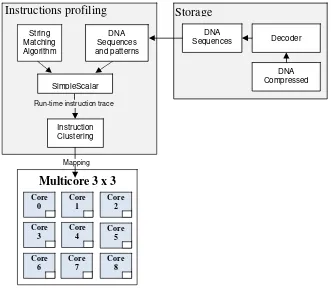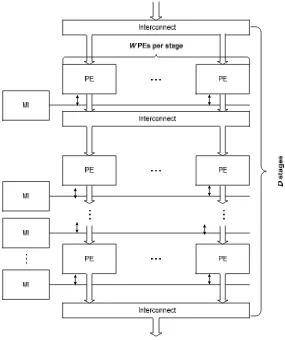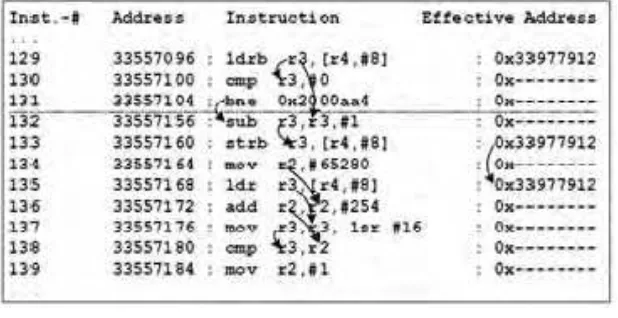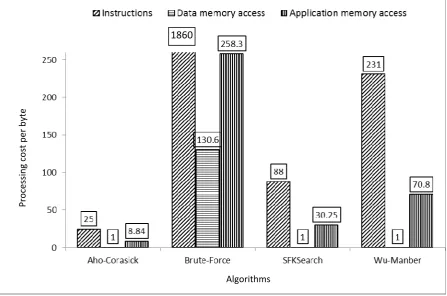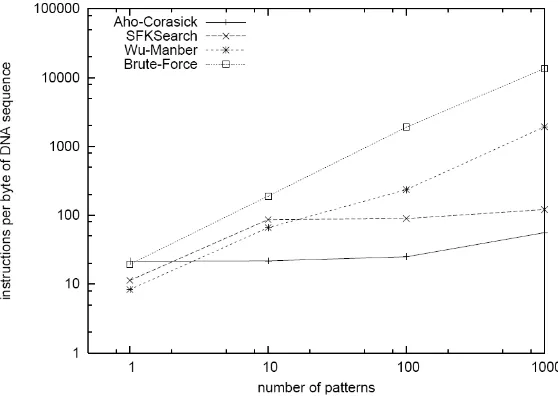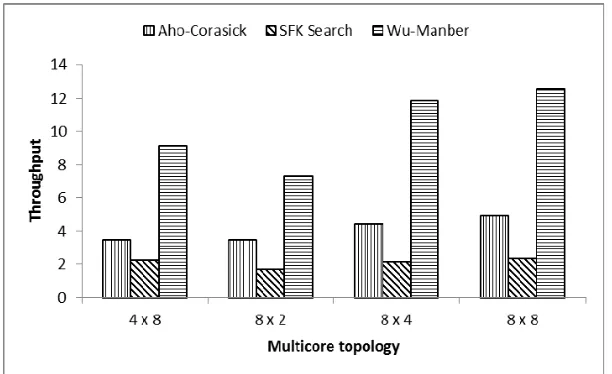DNA COMPRESSED AND SEQUENCE
SEARCHING ON MULTICORE
BENFANO SOEWITO
Department of Information Technology, Bakrie University, Jl. H.R. Rasuna Said Kav. C-22 Jakarta, 12920, Indonesia
[email protected] http://bakrie.ac.id
Abstract :
One of the used of string matching is to search DNA sequence in the DNA database. This simple operation can be done in hours or days, because the huge size of DNA sequence database. On the other hand, the potential of multicore for DNA sequence searching is not fully explored due to the difficulty of multicore programming. This paper evaluates several key string matching algorithms using a comprehensive simulation framework. Starting from decoding compressed DNA sequence and instructions processor profiling, the framework constructs task graphs for string matching algorithms. Then task graphs are mapped onto multicore. The mapping technique is based on a random algorithm result in a high mapping quality. The key feature of this paper is that entire processes are automated and it requires users little understanding of the complexity of algorithms and multicore hardware architecture. DNA compressed can save up to 75% space and our framework can be as a guidance to utilize multicore for searching DNA pattern.
Keywords: DNA Sequence; Searching Algorithm; String Matching.
1. Introduction
String matching has been one of the major operations in modern world software applications: searching machine on internet, searching books in library, intrusion detection systems and etc. In modern bioengineering especially in bioinformatics: genome sequence or Deoxyribonucleic Acid (DNA) matching and string matching or sequence searching has been one of the major operations [Lu, et al. (2006)]. The basic operation of string matching is to search for predefined patterns in the database of patterns. However, this simple operation can be a bottleneck. This is caused by three factors: tens to hundreds Gigabit DNA sequence database, hundreds to thousands possible DNA patterns and the starting position of DNA pattern is probabilistic, hence it is necessary to scan every byte of a DNA sequence database. Therefore it is vital to design an efficient pattern matching based DNA sequence data base.
The DNA sequence database consist four alphabetical characters: A, C, G and T. The long sequence of DNA determines the information of living organisms. Unfortunately, the huge data of DNA sequences require large storage space and will be a problem in transferring or downloading this database.
The prior related works have focus on either pursuing mathematically efficient matching algorithms or hardware accelerator. Popular examples of software-based pattern-matching package are AGREP [Wu and Manber (1992)] in operating system, Snort [Snort (2004)] in network security, and BLAST [Miyazaki, et al. (1998)] in Bioinformatics. Meanwhile, different text compression methods [Miyazaki, et al. (1998)] [De Moura (1998)] for DNA sequences have been proposed. For example, a modified version of Boyer-Moore Derivative Boyer-Moore (d-BM) [Chen and Ram (2004)] has been proposed, which compresses both DNA sequences and patterns by using two bits to represent each A, T, C, G character (4-character 8 bit (4C8B) compression). In order to solve the misalignment problem in searching patterns with ordinary 4C8B compression, Compressed-Punctuated-Boyer-Moore (cp-BM) [Lu, et al. (2006)] uses punctuator characters to indicate unambiguously the encoding frame of the compressed target sequence. Instead of decompressing and then searching it, a modified Boyer–Moore (BM) [Navarro and Tarhio (2005)] approach is proposed to string matching over LZ78 and LZW compressed text. Recent research [Harisson, at al. (2007)] also has addressed work on 3D sequence searching for DNA sequences. The key drawback of software-based approach is lacking of scalability with rapid increasing of sequence database. Therefore different hardware accelerators [Baker and Prasanna (2004)] [Song and Lockwood (2005)] [Sugawara, et al. (2004)] have been proposed. These hardware-based accelerators are faster than software-based approach but are often expensive and lack of flexibility to update new patterns.
available string matching algorithms are optimized for uniprocessor computer architectures. They either cannot be efficiently executed by Multicore which have severe limits on fast memory or cannot fully take advantage of the high level parallelism of Multicore. On the other hand, multicore are difficult to program for high performance. Currently multicore programmers use hand-tuned and manually resource mapping approach which is not efficient for bioengineering application developers. Therefore an effective design methodology is required to explore string matching algorithms optimized for multicore.
In this paper we use bit compressed to reduce the storage of DNA sequence database. Four string matching algorithms have been chosen to compare their performances, i.e., Brute-Force, Aho-corasick, SFKSearch and Wu-Manber. Our simulation environment as shown in Fig.1, consists of storage, instructions profiling and multicores. After clustering instructions, the mapping technique will be applied to optimize performance system on multicores. Finally the rest of the paper is organized as follows. In section 2, we discuss fundamental theory. We quantify the performance of matching algorithm in the context of single processor, mapping technique and simulation on multicore in section 3. Results are presented and discussed in section 4. Section 5 summarizes and concludes the paper.
Fig. 1. Simulation environment
2. Fundamental Theory
2.1. String matching algorithms
Pattern searching or string matching algorithm is a common important operation in many applications. For example: flow classification in computer networks, network intrusion detection [Denning (1987)] in network security and DNA sequence database in bioinformatics (such as identification of conserved regulatory sequences and the design of hybridization probe [Lu, et al. (2006)]).
In this paper four string matching algorithms have been chosen for evaluation: Aho-Corasick, Brute-Force, SFKSearch and Wu-Manber. Brute-Force is a single-string matching algorithm as our baseline. The rest of three are multiple matching algorithms, which are a representative of multiple sequence searching algorithms. In this paper, we employ following notations: n, DNA sequence size; m, pattern length and p, number of patterns. Should note, the proposed methodology can evaluate any string matching algorithm, the selected algorithms used in this paper serves as an illustration example.
The Aho-Corasick [Aho and Corasick (1975)] using a finite automaton, is able to match patterns linear in the size of input string. The number of state transitions made by the sequence searching machine in processing the
Multicore 3 x 3
Core 0
Core 1
Core 2
Core 3
Core 4
Core 5
Core 6
Core 7
Core 8
Instructions profiling
String Matching Algorithm
DNA Sequences and patterns
SimpleScalar
Run-time instruction trace
Instruction Clustering
Mapping
DNA
Sequences Decoder
DNA Compressed
text string is independent of the number of patterns. This algorithm never backtracks in the input string and examines each character of the input string only once.
The Brute-Force scans every byte of the DNA sequence in the position between 0 and n-m, whether an occurrence of the pattern starts there or not. After each attempt, the pattern is shifted exactly one position to the right. The same procedure is repeated for each of p patterns. The time complexity of the searching phase is O
(nmp). Brute-force is the simplest pattern searching algorithm which requires no preprocessing phase, which
serves as our comparison baseline.
The SFKSearch [Snort (2004)] uses trie data structure and bad character shift table to optimize search. A bad character shift table is used to advance through search text until it encounters a possible start of a match string, at which point it traverses the trie looking for matches. Each level in the trie is a sequential list of sibling nodes that contain a pointer to matching patterns, a character that must be matched to traverse to their child node and a pointer to the next sibling node.
The Wu-Manber algorithm [Wu and Manber (1992)] starts by pre-computing two tables: a bad character shift table and a hash table. The bad character shift table is used to accelerate the searching by providing a byte skipping and the hash table is used to create sub-groups of patterns.
2.2. Analytical performance model for multicore architecture
Our general parameterized multicore topology shown in Fig. 2. consists of three components: processing elements, shared interconnects, and memory interfaces. The data move from top to bottom. The key parameters are: the width of the pipeline stage (W), the depth of the pipeline stage (D), the number of stages per communication interconnects (I) and the number of memory channels shared by one row of processing elements (M).
Fig. 2. General and parameterized multicore architecture
The system throughput is determined by modeling the processing time for each processing element in the system based on its workload, the memory contention on each memory interface, and the communication overhead between stages. We are particularly interested in the maximal latency, max
stage
synchronized nature of pipelined architecture. With the number of parallel matches that are mapped to an architecture,
n
p, the throughput of the system is expressed as:max stage p
n
throughput
(1)where the maximum stage time is the maximum time that any of the D stages spends on processing, iprocj
,
, andmemory accesses, memi j
,
, and communication time, commi j,
:(
(
))
, , , 1 max 1max i j
mem j i proc j i comm stage j W i MAX D
(2)
For a general purpose RISC processor with single-cycle instructions, the processing time, iprocj
,
, depends solely on the number of instructions, instri,jthat are mapped to this processing element during the mapping phase:
instr
i jj i
proc ,
,
(3)The memory access time is the sum of the queuing time due to contention and the actual memory access time. The queuing system can be modeled as a Machine Repairman model with a fixed number of sources (i.e., processing elements) and a certain number of servers (i.e., memory channels). There is no closed form solution for the Machine Repairman system. Instead the result is computed iteratively over the number of job servers. The response time for a system with n job servers is
1
2
.
1
2
1 1 11
n n n nn
R
S
U
U
S
SQ
S
R
(4)where S is the service time of the memory interface, Un1is the utilization of the memory interface when there
are n −1 processing elements active in the system, and Qn1is the number of requests present at the memory
interface (including the current one served), if there are n −1 processing elements active in the system. With the response time Rn, the number of memory read ri,j and write wi,j , the overall memory access time for a processing element can be determined as
(
, ,)
, j i j i j imme
R
n
r
w
(5)The communication time of a stage depends on the total amount of data that needs to be transferred across the interconnect. The amount of data that is communicated across an interconnect1kD,datak, is:
(
)
1 ) , ( 1 , ), ,( i j k i D j w w j k i j i data
dep
k
(6)Where
dep
(i,j),(i,j) is the amount of data transferred from processor(
i
,
j
)
to processor(
i
,
j
)
. Assuming each data element can be communicated in one clock cycle, the stage communication cost is:
k data k
comm
(7)3. Methodology
3.1.Storage in bit compressed
The DNA sequences consist of four nucleotide: A, C, G, and T. A DNA sequence for an organism can be long and contain a lot of information. Large numbers of DNA sequences require efficient storage. Typical genomic databases are large: human genome alone has approx. 3.2 GB, and the GenBank traditional database contains more than 100 GB of DNA sequences as of April 2010. The compressed pattern matching problem attracted special interest, with the goal of enhancing storage efficiency while speeding up the search time.
In this paper we use two bits encoding method for our experimental. In this case, we can simply use two bits to encode each character, i.e. 00 for a, 01 for c, 10 for g, and 11 for t. For illustration, sequence actgccag that has eight characters needs 64 bits. We encode using two bits encoding: 00 01 11 10 01 01 00 10 that needs 16 bits in total. It’s mean save 75% of storage.
3.2.Instruction processor profiling
The goal of instructions profiling is to determine the workload processing cost of a searching algorithm. To characterize the workload of sequence searching algorithms, we execute them using SimpleScalar [Austin, et al. (2002)], which is a single processor workload simulator. SimpleScalar takes the matching algorithm implemented in C code, DNA sequence and patterns as input, outputs different kinds of performance metrics.
The first metric is number of instructions and memory accesses to execute an algorithm. Fig. 3 shown the example of instructions. To eliminate the DNA sequence size impact, we consider the byte-average processing cost. The second metric is processing cost scalability with DNA sequence size and number of patterns. The third metric is run-time storage requirement. The last metric is inherent parallelism of algorithm workload, which is represented using acyclic task graph. The workload profiling and its results will be used for instructions clustering, mapping and performance evaluation.
The dynamic workload of a string matching algorithm depends not only on the queries, but also the content of DNA sequence. The DNA sequence database used in this work is NCBI [http://ncbi.nlm.nih.gov]. The test queries are randomly generated by selecting a substring of give length (100 bytes in our experimental result) from a DNA sequence above.
Fig. 3. Instructions
3.3.Instruction clustering and mapping
After simulating these algorithms, collecting run-time traces or instructions, we identifying them and clustering the instructions based on dependencies. To show the potential parallelism of matching operation, we represent the instructions using an Annotated Directed Acyclic Graph (ADAG) as shown in Fig.4. These ADAG show processing requirements in terms of instructions, memory accesses and communication cost. Also, the interdependency shown in ADAG demonstrates the nature of the matching algorithm.
4. Experimental Results
The cost of different string processing algorithms according to several scenarios in a variety of patterns in a single processor is shown in Fig. 5. The result produced by the size of the DNA sequence of 3K bytes and 100 patterns with the pattern size of 100 bytes. From the figure, we can draw the following conclusions: all algorithms, except the Brute-Force algorithm, require the same amount of DNA sequence memory accesses. This is due to Brute-Force scanning the entire DNA sequences for each pattern; here we use 100 patterns as mentioned above; the remaining three, scans the DNA sequence only once. Aho-Corasick is the best in terms of the number of instructions and memory access. This is due to the difference of the operation of the algorithm: Aho-Corasick, the search operation only runs through to the next character in the trie or failure to follow the pointer. Manber performance is worse than the other two algorithms because of the nature of the Wu-Manber algorithm that should go to the table prefix, which require more instruction and memory access.
Fig. 5. DNA Sequence Byte-Average Processing Cost for Different Algorithms.
The scalability of number of instructions of Wu-Manber and SFK fall between Brute-Force and Aho-Corasick. Overall, this illustrates the difference of two kinds of matching algorithms: pattern-based and DNA sequence based. Brute-Force is one example of pattern-based matching algorithm, which search whole DNA sequence for every pattern; the rest three are DNA sequence-based matching algorithm, which compare the DNA sequence with all patterns at the same time, therefore, whole DNA sequence is scanned only once.
Fig. 6 and 7 shows the influence of the size of the DNA sequence and size on the pattern of processing costs. In Fig. 6, Brute-Force shows the constancy on number of instructions to process unit byte DNA sequence when DNA sequence size increasing. But the number of instructions is linearly increasing when the number of patterns increasing as shown in Fig. 7. These are the expected results, which demonstrate the truth of our simulation methodology. Aho-Corasick is the best among all the algorithms studied here, because the processing costs for the byte sequence of DNA units is independent of the size and number of patterns of DNA sequence. Scalability of the number of instructions Wu-Manber and SFK falls between the Brute-Force and Aho-Corasick. Brute-Force is one example-based pattern matching algorithm, which searches the entire DNA sequence for each pattern, the rest three are DNA sequence-based matching algorithm, which compares the DNA sequence with all the patterns at the same time, therefore, the entire DNA sequence is scanned only all.
We clustering the instruction and were represented using ADAG. We mapping these instructions graph to multicore using randomized mapping algorithm to optimize system performance, which is presented in Fig. 8.
Algorithms
Processing
cos
t
per
byte
Fig. 6. Processing Cost Depending on DNA Sequence Size. The processing cost is the average number of instructions to process one byte DNA sequence, and the number of queries is 100 patterns with each pattern have the length of 100 bytes.
We also did mapping these instructions using genetic algorithm as a comparison. Each algorithm, four design instances of our design space is explored with different pipeline width w. The most unexpected results is Manber is doing much better than Aho-Corasick algorithm, which has smaller processing cost than Wu-Manber in single processor. This indicate better algorithm in single processor not necessarily performance equally well in multicore. However, as we found from ADAG, Wu-Manber has shown task-level parallelism, which might contribute to this performance gain.
We encode the DNA sequence database using two bits encoding. To demonstrate this compression, we chose the human genome alone that has approx. 3.2 GB as object of our experimental. The program to encode is made in our lab and we found the size of human genome is 0.9 GB after encoding process.
Fig. 7. Processing Cost Depending on Number of Patterns. The processing cost is the average number of instructions to process one byte DNA sequence. The size of DNA sequence is 3KB and each pattern have the length of 100 bytes.
5. Conclusions
In this work, we have introduced a methodology for mapping searching DNA pattern algorithm onto highly parallel multicore. The mapping is based on a random algorithm and also we did genetic algorithm to mapping the instruction into multicore.
Starting from algorithms processing cost and storage characterization, our methodology considers three fundamental approaches to parallelize sequence searching operations: Queries, Database and Task Clustering.
Fig. 8. Throughput of Different Multicore Topology.
The storage can reduce up to 75% using the two bit compression. The Compressed of DNA sequence database has to be decoded before searching process. It needs some time but the time to decode is very short.
With this framework, we have presented behavior of four matching algorithms using DNA sequence database and test patterns. Compared with naive Brute-Force approach, SFKSearch, Wu-Manber and Aho-Corasick demonstrate efficient processing cost and linearly scalability with the DNA sequence size and number of patterns. Shift-table based matching algorithm: SFKSearch and Wu-Manber are relative efficient due to their inherent parallelism shown in application graph. Finite automaton based Aho-Corasick does not depend on minimal DNA sequence length and shows relative small processing cost in uniprocessor; however its little inter-task parallelism has resulted in less efficiency in multicores. From clustering the instructions, Wu-Manber showed more task level parallelism. We believe this framework will guide us to search and design an efficient string matching algorithm and a suitable multicore architecture for string matching operation. This is an important step towards designing an efficient and flexible pattern engines to improve DNA sequence search. References
[1] Aho, A.; Corasick, M. (1975): Efficient string matching: An aid to bibliographic search. Communications of the ACM, vol. 18. [2] Austin, T., Larson, E.; Ernst, D. (2002): SimpleScalar: An Infrastructure for Computer System Modeling. Computer 35, 2, 59-67. [3] Baker, Z. K.; Prasanna, V.K. (2004). Time and area efficient pattern matching on fpga. Proceedings of the 2004 ACM/SIGDA 12th
international symposium on Field programmable gate arrays. New York, NY, USA: ACM Press, pp. 223-232.
[4] Chen, S. Lu; Ram, J. (2004): Compressed pattern matching in dna sequence. Proceedings of the 2004 IEEE Computational Systems Bioinformatics Conference (CSB’04), Washington, DC, USA: IEEE Computer Society, pp. 62-68.
[5] De Moura, E. S.; G. Navarro, G.; Ziviani, N; Baeza Yates, R.A. (1998): Direct pattern matching on compressed text. String Processing and Information Retrieval, pp. 90-95.
[6] Denning, D. (1987): An intrusion-detection model. IEEE Transactions on Software Engineering, vol. 13, no. 2, pp. 222-232. [7] DNA Sequence Database, National Center for Biotechnology Information, http://www.ncbi.nlm.nih.gov.
[8] Harisson, J; Payen, G.; Gherbi, R. (2007): A 3d pattern matching algorithm for dna sequence. Bioinformatics, vol. 23, no. 6, pp. 680-686.
[9] Lu, Y. S.; Ram, J. L. (2006): Fast search in dna sequence databases using punctuation and indexing.Proceedings of the 2nd IASTED
international conference on Advance in computer science and technology. Anaheim, CA, USA: ACTA Press, pp. 351-356.
[10] Miyazaki, M.; Fukamachi, S.; Takeda, M.; Shinohara, T. (1998): Speeding up the sequence searching machine for compressed texts. Transactions of Information Processing, vol.39, pp. 2638-2648.
[11] Navarro, G.; Tarhio, J. (2005): Lzgrep: a boyer moore string matching tool for ziv lempel compressed text: Research articles. Softw. Pract. Exper., vol. 35, no. 12, pp. 1107-1130.
[12] Soewito B.; Weng, N. (2007): Methodology for evaluating dna pattern searching algorithms an multicores. Proc. of the 7th IEEE
International Conference on Bioinformatics and Bioengineering, Harvard Medical School, Boston, MA, USA. IEEE.
[13] Song, H.; Lockwood, J. W. (2005): Efficient packet classification for network intrusion detection using fpga. FPGA’05: Proceedings of the 2005 ACM/SIGDA 13th international symposium on Field programmable gate arrays. New York, NY, USA: ACM Press, pp.
238-245.
[14] Sugawara, Y.; Inaba, M.; Hiraki, K. (2004): Over 10gbps string matching mechanism for multi-stream packet scanning syatems. Lecture Notes in Computer Science, vol. 3203. Springer-Verlag, pp. 484-493.
[15] The Open Source Network Intrusion Detection Systems, Snort, Inc., 2004, http://www.snort.org.
[16] Weng, N.; Wolf, T. (2005): Profiling and mapping of parallel workloads on network processors. Proc. of The 20th Annual ACM Symposium on Applied Computing (SAC), pages 890–896, Santa Fe, NM.
[17] Weng, N.; Wolf, T. (2004): Pipelining vs. multiprocessors - choosing the right network processor system topology. Proc. of Advanced Networking and Communications Hardware Workshop, Munich, Germany.
